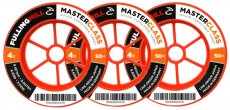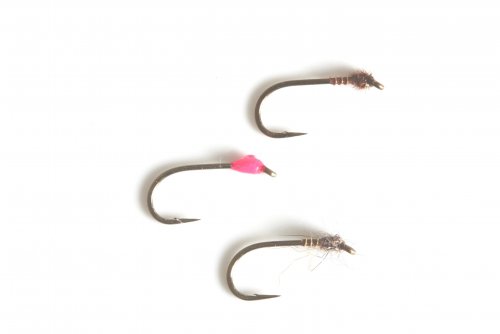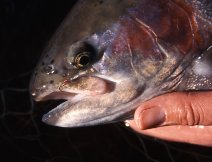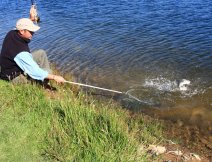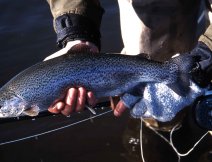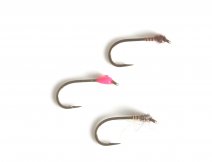The concept of bare hook nymphs is far from new.
Deep in the inky depths where the eye cannot penetrate, a whole community of bugs and nymphs go about their business. Species like shrimp, water hog-louse and corixa are entirely aquatic in their habits. Such beasties scurrying about the lakebed rarely go unnoticed and provide a year round food source for resident trout. There's a lot to be said for catching a fish, spooning it and finding your imitation matches that of the trout's stomach contents. And whilst lures take their share of the spoils, patterns like the P.T.N. and hare's ear nymph are the perfect theme on which to base your imitations. However, more recently there has been a move of refining these flies to creations that bear little in the way of any dressing.
Whisper Nymphs
The concept of bare hook nymphs is far from new. Oliver Kite is not only famed for the "Kite's Imperial" (a first rate dry fly) but arguable more so for creating the "Bare Hook Nymph." Wraps of fine copper wire form a small bump just behind the hook eye. This tiny thorax along with the hook shank instantly suggested the nymphal form of upwinged species, Kite used this almost exclusively to deadly effect. Undoubtedly it is a must for river trouting but to the modern day stillwater fisher the dressing shouts "buzzer pupa."
Kite's original was an excellent blueprint and proved an instant hit with the local trout. Yet the luxury of various coloured wires available today, inspired experimentation. Further to this, certain hook models finished in black could be matched to the black wire, resulting in simple, yet stunning flies! Whilst these bare hook variants were sound buzzer representations, fish autopsies revealed a mush of tiny immature water hog-lice and shrimps, a fraction larger than a pin head. A turn of gold wire and a wisp of hare's fur fashioned as a thorax produced the desired effect.
Why do trout take the Whisper Nymphs? There's no doubting trout see them as tiny food morsels. In particular, small buzzer pupa, other nymphs and the above mentioned hog-lice. One thing that is easily overlooked is having been subjected to every imaginable fly throughout the season, resident trout are not so much educated, as suspicious! Bright flies or those that are overdressed repeatedly spook fish, as will flies fished too close together on a leader. Often a switch to something unassuming provides the answer, by fishing drab, inoffensive patterns, trout respond positively rather than bolting to the next county.
It's all in the mind
The whole business of fishing anorexic nymphs started out as a personal quest, just to see whether they really did work? I've long been fascinated by minimal fly patterns, if only because they turn fishing theories on their head. I mean, we go to untold lengths in fashioning complex representations, only to find trout can be fooled by a humble turn of silk! Apart from Kite's bare hook nymph, incorporating short thread bodies and a turn of hackle Tummel style flies were just as deadly.
With the nymphs now well established in my fly box, fishermen would remark on their apparent nothingness! Quips like "the knot is bigger than the actual fly, what does it possibly imitate," is a frequently one. Of course when you're programmed to heavily dressed patterns, believing in scantily tied nymphs takes some doing, and that's the very secret, faith! Granted, it's easy to say, but try and fish the flies with total conviction. Though I must admit there are times when I not so much doubt the flies, they just never cease to amaze me. Staring at a double figure fish in the bottom of a landing net, the mind boggles as to why trout take such pitiful flies? And never question the trout's ability of detecting minute flies, fish have excellent vision, allowing them to see the tiniest of particles.
One other factor that presents a mental block is the issue of a bare hook shank and the "hardness" of the fly. Surely, "fish must feel the steel immediately and reject the fly," is an obvious concern? Naturally, whilst we cannot vouch for what the fish experience, I believe trout see what they want to see! When nymphing, if a fly behaves correctly and doesn't arouse suspicious, there's a good chance it will be confidently seized.
Tackling Up
Although reservoir fishing may warrant the use of an 8-weight outfit, on natural lakes and tarns you can get away be using much lighter tackle. A rod rated for a No5 line is my preferred choice, a 6-weight may provide an edge in windy conditions, yet it still has finesse. Offering precise depth control a floating line is essential for presenting the flies virtually static. Additionally, an intermediate will be useful during gales and when extra depth is required.
The first 5ft of my leader system consists of an Airflo poly leader. Of various densities they enable a range of water depths to be covered. To this I attach copolymer; Orvis Superstrong has an extremely fine diameter in relation to its breaking strain, allowing the nymphs to descend almost unhindered. Because of its reduced thickness 6lb breaking strain can be used without sacrificing presentation. For a three fly set-up, attach 3ft of 6lb Superstrong to the tapered section. Form a dropper and add another 5ft of leader material. Finally, knot on another 5ft, leaving a second dropper. Apart from the 5ft taper this 18ft leader is straight through (level), turn over is aided by not only the taper but by the use of a slightly larger fly on the point, typically two size 16 flies for the droppers, with a size 14 occupying the point position.
Testing Times
There are countless occasions when Whisper Nymphs have come to my rescue. However, a raw Spring day on Wych Elm saw the nymphs prove their worth. Early morning and ice forming in the rod rings made casting difficult. Eventually I got the line working and a team of nymphs plopped into a likely corner. For good presentation, it's best to feather the fly line with the line hand prior to the cast straightening out. This turns everything over nicely. As soon as the flies alight they're fishing, so remain watchful. Any movement, however slight needs addressing by a swift lift of the rod. During unsettled weather when the wind ruffles the surface, focussing on the fly line tip can be difficult. Instead, concentrate on the line's midsection or where line memory causes those unwanted S-shaped coils, they have a habit of straightening when a fish takes!
During flat calm conditions, search the water by fan casting. This does take time, as the best retrieve is no retrieve at all. Though if trout are holding in a tight spot, having fished the nymphs through, retrieve line quickly and recast, keeping the flies in the active zone. During a breeze, try fishing your flies across or in to the wind. Miserable and uncomfortable it may be, but your nymphs will behave far more naturally.
As expected, fish proved reluctant to feed in the cold morning air. After lunch a lazy sun lifted the temperature above freezing and trout began feeding. Casting parallel to the bank on a flooded Wych Elm was the order of the day, as trout were virtually patrolling on what should have been dry land. A light breeze helped swing the flies seductively to feeding fish, which couldn't resist inhaling the tiny fragments of fur!
Dressing of Whisper Nymphs:
P.T.N. Whisper
Hook: Mustad R50 size 14-16
Thread: Brown 8/0
Rib: Finest copper wire
Body: Tying thread
Thorax: Cock pheasant tail-two strands
The simplest pheasant tail ever.
Hare's Ear Whisper
Hook: Mustad R50 size 14-16
Thread: Brown 8/0
Rib: Finest gold wire
Body: Tying thread
Thorax: Hare's mask
Keep the guard hair to a minimum, so that a nice, neat thorax can be easily achieved.
Pink Speck
Hook: Mustad R50 size 14-16
Thread: Wapsi Ultra thread Fluor pink
Thorax: Tying thread
A coat of varnish renders the fly bomb proof.








